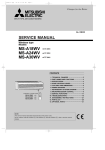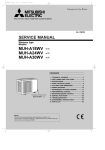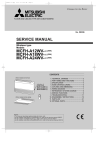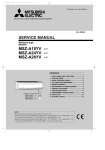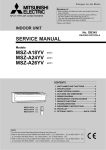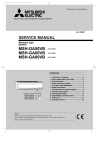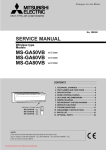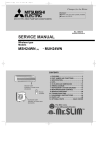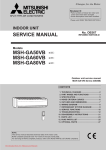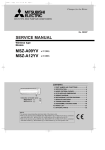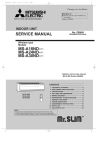Download Mitsubishi MSH-A30WV Service manual
Transcript
OB321-1.qxp
03.11.13 4:03 PM
Page 1
SPLIT-TYPE, HEAT PUMP AIR CONDITIONERS
No. OB321
SERVICE MANUAL
Wireless type
Models
MSH-A18WV MSH-A24WV MSH-A30WV -
E1
(WH)
E1
(WH)
E1
(WH)
CONTENTS
Indication of model name
MSH-A18WV MSH-A24WV MSH-A30WV -
E1
E1
E1
1. TECHNICAL CHANGES ····································2
2. PART NAMES AND FUNCTIONS······················2
3. SPECIFICATION·················································4
4. NOISE CRITERIA CURVES ·······························5
5. OUTLINES AND DIMENSIONS ·························6
6. WIRING DIAGRAM ············································7
7. REFRIGERANT SYSTEM DIAGRAM ················8
8. MICROPROCESSOR CONTROL ······················9
9. SERVICE FUNCTIONS ····································18
10. TROUBLESHOOTING······································20
11. DISASSEMBLY INSTRUCTIONS·····················28
12. PARTS LIST······················································30
13. OPTIONAL PARTS ······················BACK COVER
NOTE:
This service manual describes technical data of the indoor unit.
•Refer to the service manual OB322 when MSH-A18WV- E1 , MSH-A24WV- E1 or MSH-A30WV- E1 is
connected with MUH-A18WV- E1 , MUH-A24WV- E1 or MUH-A30WV- E1 .
•Refer to the service manual OB319 when MSH-A18WV- E1 is connected with MXZ-A18WV- E1 ,
MXZ-A26WV- E1 or MXZ-A32WV- E1 as multi system units.
•Refer to the service manual OB319 when MSH-A24WV- E1 is connected with MXZ-A26WV- E1 or
MXZ-A32WV- E1 as multi system units.
OB321-1.qxp
1
03.11.13 4:03 PM
Page 2
TECHNICAL CHANGES
MSH-18RV - E2 ➔MSH-A18WV - E1
1. Indoor unit model has changed.
2. Rated voltage has changed. (220V-240V ➜ 230V)
3. Remote controller has changed.
•LONG MODE and WIDE MODE have been added.
4. Indoor fan motor has changed.(RA4V27-EF ➜ RC4V32-AA)
5. Indoor heat exchanger has changed.
6. Diameter of connect pipe has changed.(Liquid:[8 ➜ [6.35)
7. Air cleaning filter has changed to catechin air filter.
MSH-24RV - E2 ➔MSH-A24WV - E1
1. Indoor unit model has changed.
2. Rated voltage has changed. (220V-240V ➜ 230V)
3. Remote controller has changed.
•LONG MODE and WIDE MODE have been added.
4. Indoor fan motor has changed.(RA4V27-EE ➜ RC4V32-AA)
5. Indoor heat exchanger has changed.
6. Diameter of connect pipe has changed.(Liquid:[8 ➜ [6.35)
7. Air cleaning filter has changed to catechin air filter.
MSH-30RV - E1 ➔MSH-A30WV - E1
1. Diameter of connect pipe has changed.(Gas:[15.88 ➜ [12)
2. Rated voltage has changed. (220V-240V ➜ 230V)
3. Power supply cord has been added.
4. Air cleaning filter has changed to catechin air filter.
2
PART NAMES AND FUNCTIONS
INDOOR UNIT
MSH-A18WV - E1
MSH-A24WV - E1
MSH-A30WV - E1
Grille
Air cleaning filter (option)
(White bellows type)
Air inlet
Front panel
Remote control
receiving section
Catechin air filter
Vertical vanes
Horizontal vane
Remote controller
Operation section
Display section
(When the grille is opened)
Operation indicator lamp
Operation Indicator
Emergency operation switch
Remote control
receiving section
ACCESSORIES
Indoor unit
1
2
3
4
5
6
7
Installation plate
Installation plate fixing screw 4 o 25 mm
Remote controller holder
Fixing screw for 3 o 3.5 o 1.6 mm (Black)
Battery (AAA) for remote controller
Wireless remote controller
Felt tape (Used for left or left-rear piping)
2
MSH-A18WVMSH-A24WVMSH-A30WV1
7
1
2
2
1
1
E1
E1
E1
OB321-1.qxp
03.11.13 4:03 PM
Page 3
REMOTE CONTROLLER
MSH-A18WV - E1
MSH-A24WV - E1
MSH-A30WV - E1
Signal transmitting section
Operation display section
PM
OPERATE /STOP
(ON /OFF)button
AM
TOO
ON/OFF WARM
TOO
COOL
TEMPERATURE buttons
Indication of remote controller
model is on back.
Open the front lid.
CLOCK
PM
AM
TOO
ON/OFF WARM
VANE button
(Horizontal vane button)
TOO
COOL
FAN
STOP
VANE
START
I FEEL COOL
FAN SPEED CONTROL button
OFF-TIMER button
HEAT DRY
ON-TIMER button
MODE WIDE VANE
HR.
OPERATION SELECT button
ECONO COOL
LONG
ECONO COOL button
MIN.
HR. button
MIN. button
(TIME SET button)
RESET CLOCK
CLOCK SET button
WIDE VANE button
(Vertical vane button)
LONG button
RESET button
3
OB321-1.qxp
3
03.11.13 4:03 PM
Page 4
SPECIFICATION
•Refer to the service manual OB322 when MSH-A18WV- E1 , MSH-A24WV- E1 or MSH-A30WV- E1 is connected with
MUH-A18WV- E1 , MUH-A24WV- E1 or MUH-A30WV- E1 .
•Refer to the service manual OB319 when MSH-A18WV- E1 is connected with MXZ-A18WV- E1 , MXZ-A26WV- E1 or
MXZ-A32WV- E1 as multi system units.
•Refer to the service manual OB319 when MSH-A24WV- E1 is connected with MXZ-A26WV- E1 or MXZ-A32WV- E1 as multi
system units.
Indoor model
MSH-A18WV Cooling
Function
Power supply
Special
remarks
Fan
motor
Electrical
data
Capacity Air flow(High/Med.w/Low w ) K /h
Power outlet
A
Running current
A
Power input
W
Auxiliary heater
A(kW)
Power factor
%
Fan motor current
A
Model
Winding
"
resistance(at20:)
Dimensions WOHOD
mm
Weight
kg
Air direction
Sound level(High/Med.w /Low w)
dB
Fan speed(High/Med.w /Loww ) rpm
Fan speed regulator
Thermistor RT11(at25:)
k"
Thermistor RT12(at25:)
k"
Remote controller model
Heating
Single phase
230V, 50Hz
768/642 w/528 w
10
0.3
60
—
87
0.30
RC4V32-AA
WHT-BLK 293
BLK-RED 146
1,100O325O227
16
5
42/38w /34 w
1,070/920w /780w
3
10
10
KP0A
Electrical
data
Fan
motor
Special
remarks
Heating
Single phase
230V, 50Hz
768/672 w /588 w
768/642 w/528 w
10
0.3
60
—
87
0.30
RC4V32-AA
WHT-BLK 293
BLK-RED 146
1,100O325O227
16
5
45/40 w/34 w
45/41w /37 w
w
w
1,070/920 w/780 w
1,070/960 /850
3
10
10
KP0A
E1
Cooling
Heating
Single phase
230V, 50Hz
Power supply
Power outlet
Running current
Power input
Auxiliary heater
Power factor
Fan motor current
Model
Winding
resistance(at20:)
Dimensions WOHOD
Weight
Air direction
Sound level(High/Med.w/Low w )
Fan speed(High/Med.w /Low w )
Fan speed regulator
Thermistor RT11(at25:)
Thermistor RT12(at25:)
Thermistor RT13(at25:)
Remote controller model
E1
Cooling
MSH-A30WV -
Indoor model
Function
Capacity Air flow(High/Med.w/Low w )
MSH-A24WV -
E1
K /h
A
A
W
A(kW)
%
A
960/822w /684 w
10
0.34
69
—
88
0.34
RC4V40-AA
WHT-BLK 138.2
BLK-RED 159.0
1,100O325O227
16
5
47/42 w /37 w
"
mm
kg
dB
rpm
960/834w /732 w
1,280/1,130w /970 w
1,280/1,150 w/1,020 w
3
10
10
10
KP0A
k"
k"
k"
NOTE: Test conditions are based on JIS C 9612.
Cooling : Indoor DB27°C WB19°C
Heating : Indoor DB20°C WB 15.5°C
Outdoor DB35°C WB(24°C)
Outdoor DB 7°C WB 6°C
Indoor-Outdoor piping length 5m
w Reference value
4
OB321-1.qxp
03.11.13 4:03 PM
Page 5
NOISE CRITERIA CURVES
4
MSH-A18WV- E1
MSH-A24WV- E1
FAN SPEED SPL(dB(A))
High
FAN SPEED SPL(dB(A))
LINE
High
42
80
70
NC-70
60
NC-60
50
NC-50
40
NC-40
30
NC-30
20
10
APPROXIMATE
THRESHOLD OF
HEARING FOR
CONTINUOUS
NOISE
63
125
NC-20
250
500
1000
2000
4000
80
70
NC-70
60
NC-60
50
NC-50
40
NC-40
30
NC-30
20
10
8000
45
Test conditions,
Cooling : Dry-bulb temperature 27: Wet-bulb temperature 19:
Heating : Dry-bulb temperature 20: Wet-bulb temperature 15.5:
90
OCTAVE BAND SOUND PRESSURE LEVEL, dB re 0.0002 MICRO BAR
OCTAVE BAND SOUND PRESSURE LEVEL, dB re 0.0002 MICRO BAR
Test conditions,
Cooling : Dry-bulb temperature 27: Wet-bulb temperature 19:
Heating : Dry-bulb temperature 20: Wet-bulb temperature 15.5:
90
APPROXIMATE
THRESHOLD OF
HEARING FOR
CONTINUOUS
NOISE
63
BAND CENTER FREQUENCIES, Hz
125
NC-20
250
500
1000
2000
High
LINE
47
OCTAVE BAND SOUND PRESSURE LEVEL, dB re 0.0002 MICRO BAR
Test conditions,
Cooling : Dry-bulb temperature 27: Wet-bulb temperature 19:
Heating : Dry-bulb temperature 20: Wet-bulb temperature 15.5:
90
80
WALL
1m
MICROPHONE
NC-70
60
NC-60
50
NC-50
40
NC-40
30
NC-30
10
INDOORUNIT
0.8m
70
20
APPROXIMATE
THRESHOLD OF
HEARING FOR
CONTINUOUS
NOISE
63
125
NC-20
250
500
1000
2000
4000
4000
BAND CENTER FREQUENCIES, Hz
MSH-A30WV- E1
FAN SPEED SPL(dB(A))
8000
BAND CENTER FREQUENCIES, Hz
5
LINE
8000
OB321-1.qxp
03.11.13 4:03 PM
5
Page 6
OUTLINES AND DIMENSIONS
MSH-A18WV - E1
MSH-A24WV - E1
MSH-A30WV - E1
Unit: mm
INDOOR UNIT
Installation plate
Indoor unit
7.5
173
98
414.5
414.5
173
47
2.5
47
255.5
1068
315
98
Wall hole [ 75
225
1100
325
{
Air in
791
56
{
253
Air out
19
Power supply cord
Lead to right 2.0m
Lead to left 1.0m
162
58
5
Wireless remote controller
6
Installation plate Liquid line [ 6.35- 0.5m
Gas line [ 12-0.43m
Insulation [ 50 O.D
[ 32 I.D
for MSH-A18/A24WV
Liquid line [ 9.52- 0.5m
Gas line [ 12-0.43m
Insulation [ 50 O.D
[ 32 I.D
for MSH-A30WV
Drain hose [ 16
(Connected part O.D)
Insulation [ 28
03.11.13 4:03 PM
6
Page 7
WIRING DIAGRAM
MSH-A18WV - E1
MSH-A24WV - E1 MODELS WIRING DIAGRAM
INDOOR UNIT
TO OUTDOOR
UNIT
CONNECTING
12V
HIC1
3
TB
N
POWER
SUPPLY
CORD
~/N 230V
50Hz
BLU
L
2
1
BRN
CN
151
BRN
BLU
NR11
3
2
1
TRANS
TAB12
F11
CN
102
15
RT12
CN112
CN201
RED
BLK
GRY
YLW
BRN
WHT
RED
3
1
3
4
C11
SR141
CN211
ELECTRONIC CONTROL CN
P.C. BOARD
111
CN
101
3
CN
121
1
2
3
4
5
6
MF
RT11
3
PE
MV2 MV2 MV1
GRN/YLW
CIRCUIT
BREAKER
SYMBOL
NAME
SYMBOL
NAME
MV1
VANE MOTOR (HORIZONTAL)
RT12
INDOOR COIL THERMISTOR
FUSE (3.15A)
MV2
VANE MOTOR (VERTICAL)
DC/DC CONVERTER
NR11
VARISTOR
INDOOR FAN MOTOR (INNER FUSE)
RT11
ROOM TEMPERATURE THERMISTOR
INDOOR FAN CAPACITOR
F11
MF
RECEIVER
P.C.BOARD
SYMBOL
NAME
C11
HIC1
DISPLAY
P.C.BOARD
REMOTE
CONTROLLER
SOLID STATE RELAY
SR141
TERMINAL BLOCK
TB
NOTES: 1.About the outdoor side electric wiring refer to the outdoor unit electric wiring diagram for servicing.
2.Use copper conductors only. (For field wiring)
3.Symbols below indicate.
VG79J878H02
: Connector
: Terminal block
MSH-A30WV - E1 MODEL WIRING DIAGRAM
INDOOR UNIT
TO OUTDOOR
UNIT
CONNECTING
12V
3
TB
BLU
L
BRN
CN
151
NR11
3
2
1
TRANS
TAB12
F11
CN
102
15
3
CN
121
C11
SR141
RT12
1
3
4
3
BLK
GRY
YLW
BRN
WHT
RED
MF
CN211
ELECTRONIC CONTROL
P.C. BOARD
CN
101
BRN
BLU
RT13
CN112
CN201
RED
N
POWER
SUPPLY
CORD
~/N 230V
50Hz
4
3
2
1
HIC1
CN
111
RT11
3
PE
CIRCUIT
BREAKER
SYMBOL
GRN/YLW
OB321-1.qxp
MV2 MV2 MV1
NAME
DISPLAY
P.C.BOARD
RECEIVER
P.C.BOARD
REMOTE
CONTROLLER
NAME
SYMBOL
C11
INDOOR FAN CAPACITOR
MV2
VANE MOTOR(VERTICAL)
F11
FUSE(3.15A)
NR11
VARISTOR
DC/DC CONVERTER
RT11
ROOM TEMPERATURE THERMISTOR
MF
INDOOR FAN MOTOR(INNER PROTECTOR)
RT12
INDOOR COIL THERMISTOR (MAIN)
MV1
VANE MOTOR(HORIZONTAL)
RT13
INDOOR COIL THERMISTOR (SUB)
HIC1
NOTE:1. About the outdoor side electric wiring refer to the outdoor unit electric wiring diagram for servicing.
2. Use copper conductors only. (For field wiring)
3. Symbols below indicate.
/: Terminal block,
: Connector
7
SYMBOL
SR141
TB
NAME
SOLID STATE RELAY
TERMINAL BLOCK
SG79J880H02
OB321-1.qxp
7
03.11.13 4:03 PM
Page 8
REFRIGERANT SYSTEM DIAGRAM
MSH-A18WV - E1
MSH-A24WV - E1
INDOOR UNIT
INDOOR UNIT
Refrigerant pipe [15.88
(with heat insulator)
Refrigerant pipe [12.7
(with heat insulator)
Indoor
heat
exchanger
Indoor coil
thermistor
RT12
Distributor
Indoor
heat
exchanger
Flared connection
Room temperature
thermistor
RT11
Indoor coil
thermistor
RT12
Distributor
Flared connection
Refrigerant pipe[6.35
(with heat insulator)
Refrigerant pipe [6.35
(with heat insulator)
MSH-A30WV - E1
INDOOR UNIT
Refrigerant pipe [15.88
(with heat insulator)
Indoor coil
thermistor
RT12(main)
Flared connection
Room temperature
thermistor
RT11
Flared connection
Indoor
heat
exchanger
Unit:mm
Flared connection
Indoor coil
thermistor
RT13(sub)
Room temperature
thermistor
RT11
Strainer
#50
Flared connection
Refrigerant pipe [9.52
(with heat insulator)
Refrigerant flow in cooling
Refrigerant flow in heating
8
OB321-1.qxp
03.11.13 4:03 PM
8
Page 9
MICROPROCESSOR CONTROL
MSH-A18WV - E1
MSH-A24WV - E1
MSH-A30WV - E1
WIRELESS REMOTE CONTROLLER
Signal transmitting section
Operation display section
PM
AM
OPERATE /STOP
(ON /OFF)button
TOO
ON/OFF WARM
TOO
COOL
TEMPERATURE buttons
CLOCK
PM
AM
TOO
ON/OFF WARM
VANE button
(Horizontal vane button)
TOO
COOL
FAN
STOP
VANE
START
I FEEL COOL
OFF-TIMER button
HEAT DRY
ON-TIMER button
MODE WIDE VANE
HR.
OPERATION SELECT button
ECONO COOL
FAN SPEED CONTROL button
LONG
ECONO COOL button
MIN.
HR. button
MIN. button
(TIME SET button)
RESET CLOCK
CLOCK SET button
WIDE VANE button
(Vertical vane button)
LONG button
RESET button
INDOOR UNIT DISPLAY SECTION
Operation Indicator lamp
The operation indicator at the right side of the indoor
unit indicates the operation state.
• The following indication applies regardless of
shape of the indicator.
Operation Indicator
lighted
not lighted
Indication
Operation state
Difference
between target
temperature
and room
temperature
This shows that the
air conditioner is
operating to reach
the target temperature.
Please wait until the
target temperature is
obtained.
Approx. 2 :
or more
This shows that the
room temperature is
approaching the
target temperature.
Once the operation mode are set, the same operation mode
can be repeated by simply turning the OPERATE/STOP
(ON/OFF) button ON.
Indoor unit receives the signal with a beep tone.
When the system turns off, 3-minute time delay will operate to
protect system from overload and compressor will not restart
for 3 minutes.
8-1. “I FEEL CONTROL” (
) OPERATION
(1) Press OPERATE/STOP (ON/OFF) button on the remote
controller. OPERATION INDICATOR lamp of the indoor
unit turns on with a beep tone.
(2) Select “I FEEL CONTROL” mode with the OPERATION
SELECT button.
(3) The operation mode is determined by the room temperature at start-up of the operation.
Approx. 2 :
or less
9
Initial room temperature
Mode
25: or more
COOL mode of
"I FEEL CONTROL"
23:to 25:
DRY mode of
"I FEEL CONTROL"
less than 23:
HEAT mode of
"I FEEL CONTROL"
OB321-1.qxp
03.11.13 4:03 PM
Page 10
•
Once the mode is fixed, the mode does not change by room temperature afterwards.
•
Under the ON-TIMER (
) operation, mode is determined according to the room temperature at the set time the
operation starts.
When the system is stopped on the remote controller, and restarted within 2 hours in “I FEEL CONTROL” (
) mode,
the system operates in previous mode automatically regardless of the room temperature.
•
Operation time chart
Example
Previous operation
COOL mode of
“I FEEL CONTROL”
or COOL mode
Restart
COOL mode of
“I FEEL CONTROL”
When the system is restarted after 2 hours and more, the operation mode is determined by the room temperature at
start-up of the operation.
Operation time chart
Restart
Example
COOL or DRY or
HEAT mode of “I FEEL
Previous operation
CONTROL” that deterCOOL mode of
mined by room tem“I FEEL CONTROL”
perature at start-up of
the operation.
or COOL mode
(4) The initial set temperature is decided by the initial room temperature.
Model
Initial room temperature
COOL mode of
"I FEEL CONTROL"
26: or more
Initial set temperature
24:
❈1
Initial room temperature
25: to 26:
DRY mode of
"I FEEL CONTROL"
23: to 25:
HEAT mode of
"I FEEL CONTROL"
less than 23:
minus 2:
Initial room temperature
minus 2:
26:
❈1 When the system is restarted with the remote controller, the system operates with the previous set temperature regardless of room temperature at restart.
The set temperature is calculated by the previous set temperature.
(5) TEMPERATURE buttons
In “I FEEL CONTROL” (
) mode, set temperature is decided by the microprocessor based on the room temperature.
In addition, set temperature can be controlled by TOO WARM or TOO COOL buttons when you feel too cool or too warm.
Each time the TOO WARM or TOO COOL button is pressed, the indoor unit receives the signal and emits a beep tone.
• Fuzzy control
When the TOO COOL or TOO WARM button is pressed, the microprocessor changes the set temperature, considering
the room temperature, the frequency of pressing TOO COOL or TOO WARM button and the user’s preference to heat or
cool. So this is called “Fuzzy control”, and works only in “I FEEL CONTROL” mode.
In DRY mode of “I FEEL CONTROL”, the set temperature doesn’t change.
TOO
COOL
… To raise the set temperature 1~2 degrees(°C)
TOO
WARM
… To lower the set temperature 1~2 degrees(°C)
10
OB321-1.qxp
03.11.13 4:03 PM
Page 11
8-1-1. COOL mode of “I FEEL CONTROL”
1. Indoor fan speed control
Indoor fan operates at the set speed by FAN SPEED CONTROL button.
In AUTO the fan speed is as follows.
Initial temperature difference
Fan Speed
Room temperature minus set temperature : 1.7 degrees or more··························High
Room temperature minus set temperature : Between 1 and 1.7 degrees················Med.
Room temperature minus set temperature : less than 1 degree······························Low
Difference between room
temperature and set temperature
during operation
3deg.
1deg. 1.7deg.
2. Coil frost prevention
① Temperature control
When the indoor coil thermistor RT12 reads 3°C or below(MSH-A18WV) /0°C or below(MSH-A24WV)/ RT12 or RT13
reads 1°C or below (MSH-A30WV), the coil frost prevention mode starts immediately.
However, the coil frost prevention doesn’t work for 5 minutes since the compressor has started.
The indoor fan operates at the set speed and the compressor stops for 5 minutes.
After that, if RT12 still reads below 3°C(MSH-A18WV)/ 0°C(MSH-A24WV)/ RT12 or RT13 still reads below 1°C (MSHA30WV) this mode prolonged until the RT12 reads over 3°C(MSH-A18WV)/ 0°C(MSH-A24WV) / RT12 or RT13 still reads
over 1°C(MSH-A30WV).
② Time control
When the three conditions as follows have been satisfied for 1 hour and 45 minutes, compressor stops for 3 minutes.
a. Compressor has been continuously operating.
b. Indoor fan speed is Low or Med.
c. Room temperature is below 26°C.
When compressor stops, the accumulated time is cancelled and when compressor restarts, time counting starts from the
beginning.
Time counting also stops temporarily when the indoor fan speed becomes High or the room temperature exceeds
26°C. However, when two of the above conditions (b.and c.) are satisfied again. Time accumulation is resumed.
Operation chart
Example
Compressor
Outdoor fan
Indoor fan
ON
ON
OFF
OFF
ON (continuously at set speed)
NOTE : As for outdoor fan speed control and discharge temperature protection, refer to service manual for outdoor
unit.
8-1-2. DRY mode of “I FEEL CONTROL”
The system for dry operation uses the same refrigerant circuit as the cooling circuit.
The compressor and the indoor fan are controlled by the room temperature.
By such controls, indoor flow amounts will be reduced in order to lower humidity without much room temperature decrease.
1. Indoor fan speed control
Indoor fan operates at the set speed by FAN SPEED CONTROL button.
However, in AUTO fan operation, fan speed becomes Low.
2. The operation of the compressor and indoor/ outdoor fan
Compressor operates by room temperature control and time control.
Set temperature is controlled to fall 2°C from initial room temperature.
Indoor fan and outdoor fan operate in the same cycle as the compressor.
•When the room temperature is 23°C or over:
When the thermostat is ON, the compressor repeats 8 minutes ON and 3 minutes OFF.
When the thermostat is OFF, the compressor repeats 4 minutes OFF and 1 minute ON.
•When the room temperature is under 23°C.
When the thermostat is ON, the compressor repeats 2 minutes ON and 3 minutes OFF.
When the thermostat is OFF, the compressor repeats 4 minutes OFF and 1 minute ON.
11
OB321-1.qxp
03.11.13 4:03 PM
Page 12
Operation time chart
Example
ON
ON
Thermostat
OFF
OFF
Indoor fan
OFF
OFF
ON
Outdoor fan
Compressor
OFF
ON
ON
ON
OFF
ON
OFF
8 min.
ON
OFF
3 min. 4 min.
1 min.
3. Coil frost prevention
• The operation is as same as coil frost prevention during COOL mode of “I FEEL CONTROL”.
• Indoor fan operates at the set speed and the compressor stops for 5 minutes, because protection(Coil frost
prevention) has the priority.
However, when coil frost prevention works while the compressor is not operating, it’s speed becomes Low.
NOTE : As for outdoor fan speed control, refer to service manual for outdoor unit.
8-1-3. HEAT mode of “I FEEL CONTROL”
1. Indoor fan speed control
(1) In AUTO the fan speed is as follows.
Difference between room
temperature and set temperature
during operation
Initial temperature difference
Fan speed
Set temperature minus room temperature: 2 degrees or more················································· High
Set temperature minus room temperature: Between 1 and 2 degrees ····································· Med.
2deg. 4deg.
Set temperature minus room temperature: less than 1 degree················································· Low
1deg. 1.7deg.
(2) Cold air prevention control
The fan runs at set speed when the indoor coil thermistor RT12 temperature exceeds 22°C. The fan operates Low when
the temperature of indoor coil thermistor RT12 is below 18°C. But the fan stops when the indoor fan operates at Very
Low and the room temperature is 15°C or less.
Indoor coil thermistor
Released
RT12 temperature
Cold Air Prevention
18: 22:
Fan speed
Set speed
Very Low or stop
NOTE : If the temperature of RT12 reads from 18°C to 22°C at the air conditioner starting and also after defrosting, this
control works.
(3) Warm air control.
When compressor starts in heating operation or after defrosting, the fan changes the speed due to the indoor coil thermistor RT12 temperature to blow out warm air.
After releasing of cold air prevention, when the indoor coil thermistor RT12 temperature is 37°C or above, the fan speed
shifts to the set speed, and when the fan speed is changed by the remote controller, the fan speed is the set speed.
When the indoor coil thermistor RT12 temperature is less than 37°C, the fan speed is controlled by time as below.
<Time condition>
<Indoor fan speed>
less than 2 minutes ························Low
2 minutes to 4 minutes···················Med.
4 minutes or more ··························High
The upper limit of the fan speed is the set speed.
If the thermostat turns off, this operation changes to flow soft control.
(4) Flow soft control
After the thermostat turns off, the indoor fan operates at Very Low.
NOTE : When the thermostat turns on, the fan operates at the set speed. Due to the cold air prevention control, the fan
does not start at set speed until the indoor coil thermistor RT12 reads 22°C or more.
NOTE : As for outdoor fan speed control, high pressure protection, discharge temperature protection, defrosting and R.V. coil control, refer to service manual for outdoor unit.
12
OB321-1.qxp
03.11.13 4:03 PM
8-2. COOL (
Page 13
) OPERATION
(1) Press OPERATE/STOP (ON/OFF) button.
OPERATION INDICATOR lamp of the indoor unit turns on with a beep tone.
(2) Select COOL mode with the OPERATION
SELECT button.
(3) Press the TEMPERATURE buttons.
(TOO WARM or TOO COOL button) to select
the desired temperature.
The setting range is 16 ~ 31°C.
✻ Indoor fan continues to operate regardless of
thermostat’s OFF-ON at set speed.
✻ Coil frost prevention is as same as COOL
mode of “I FEEL CONTROL”.
8-3. DRY (
) OPERATION
(1) Press OPERATE/STOP (ON/OFF) button.
OPERATION INDICATOR lamp of the indoor
unit turns on with a beep tone.
(2) Select DRY mode with the OPERATION
SELECT button.
(3) The microprocessor reads the room temperature and determines the set temperature. Set
temperature is as shown on the right chart.
Thermostat (SET TEMP.)does not work.
The other operations are same as DRY mode of
“I FEEL CONTROL”.
(4) DRY operation will not function when the room
temperature is 13°C or below.
8-4. HEAT (
) OPERATION
(1) Press OPERATE/STOP (ON/OFF) button.
OPERATION INDICATOR lamp of the indoor unit turns on with a beep tone.
(2) Select HEAT mode with the OPERATION SELECT button.
(3) Press TEMPERATURE buttons (TOO WARM or TOO COOL button) to select the desired temperature.
The setting range is 16 ~ 31°C.
(4) Indoor fan speed control, high pressure protection, defrosting, R.V. coil control are the same as HEAT mode of “I FEEL
CONTROL”.
8-5. INDOOR FAN MOTOR CONTROL
(1) Rotational frequency feedback control
The indoor fan motor is equipped with a rotational frequency sensor, and outputs signal to the microprocessor to
feedback the rotational frequency. Comparing the current rotational frequency with the target rotational frequency
(High, Med., Low), the microprocessor controls SR141 and adjusts fan motor electric current to make the current rotational frequency close to the target rotational frequency. With this control, when the fan speed is switched, the rotational
frequency changes smoothly.
Rotational frequency
High
High
Med.
Low
time
(2) Fan motor lock-up protection
When the rotational frequency feedback signal has not output for 12 seconds, (or when the microprocessor cannot
detect the signal for 12 seconds) the fan motor is regarded locked-up. Then the electric current to the fan motor is shut
off. 3 minutes later, the electric current is applied to the fan motor again. During the fan motor lock-up, the OPERATION
INDICATOR Indicator lamp flashes on and off to show the fan motor abnormality. (Refer to page 20.)
13
OB321-1.qxp
03.11.13 4:03 PM
Page 14
8-6. AUTO VANE OPERATION
1. Horizontal vane
(1) Vane motor drive
These models are equipped with a stepping motor for the horizontal vane. The rotating direction, speed, and angle of
the motor are controlled by pulse signals (approx. 12V) transmitted from indoor microprocessor.
(2) The horizontal vane angle and mode changes as follows by pressing the VANE button.
AUTO
1
2
Horizontal
3
Middle
4
5
Downward
Swing
(3) Positioning
The vane is once pressed to the vane stopper below to confirm the standard position and then set to the desired angle.
Confirming of standard position is performed in case of follows.
(a) When the OPERATE/STOP (ON/OFF) button is pressed. (POWER ON/ OFF)
(b) When the vane control is changed from AUTO to MANUAL.
(c) When the SWING is finished.
(d) When the test run starts.
(e) When the power supply turns ON.
(4) VANE AUTO (
) mode
In VANE AUTO mode, the microprocessor automatically determines the horizontal vane angle and operation to make
the optimum room-temperature distribution.
① In COOL and DRY operation
Vane angle is fixed to Angle 1.
➁ In HEAT operation
Vane angle is fixed to Angle 4.
(5) STOP (operation OFF) and ON-TIMER standby.
When the following cases occur, the horizontal vane returns to the closed position.
(a) When the OPERATE/STOP (ON/OFF) button is pressed (POWER OFF).
(b) When the operation is stopped by the emergency operation.
(c) When the ON-TIMER is on standby.
(6) Dew prevention
During COOL or DRY operation at Vane Angle 4 or 5 when the compressor cumulative operation time of compressor
exceeds 1 hour, the vane angle automatically changes to Angle 1 for dew prevention.
(7) SWING MODE ( )
By selecting SWING mode with the VANE button, the horizontal vane swings vertically. The remote controller displays
“ ”.
(8) Cold air prevention in HEAT operation
When any of the following conditions occurs in HEAT operation, the vane angle changes to Angle 1
automatically to prevent cold air blowing on users.
① Compressor is not operating.
➁ Defrosting is performed.
➂ Indoor coil thermistor RT12 reads 24: or below.
➃ Indoor coil thermistor RT12 temperature is raising from 24°C or below, but it does not exceed 28:.
Horizontal vane
Indoor coil thermistor RT12 temperature
Released
Set position
Cold Air Prevention
24:
28:
Angle 1
NOTE: If the temperature of RT12 reads from 24: to 28: at the air conditioner starting, this control works.
14
OB321-1.qxp
03.11.13 4:03 PM
Page 15
(9) ECONO COOL (
) operation (ECONOmical operation)
When the ECONO COOL button is pressed in COOL mode, set temperature is automatically set 2°C higher than that in
COOL mode.
Also the horizontal vane swings in various cycle according to the temperature of indoor heat exchanger(Tp(w 1)).
SWING operation makes you feel cooler than set temperature. So, even though the set temperature is higher than that
in COOL mode, the air conditioner can keep comfort. As a result, energy can be saved.
ECONO COOL operation is cancelled when the ECONO COOL button is pressed once again or VANE button is pressed
or LONG button is pressed or change to other operation mode.
NOTE : ECONO COOL operation does not work in COOL mode of “I FEEL CONTROL”.
SWING operation
w 1 Tp : • Value of RT12 (MSH-A18/A24WV)
• Minimum value of indoor coil thermistor (main) RT12 and indoor coil thermistor (sub) RT13 (MSH-A30WV)
In swing operation of ECONO COOL operation mode, the initial air flow direction is adjusted to “Horizontal”.
According to the temperature of indoor coil thermistor Tp(w 1) at starting of this operation, next downward blow time is
decided. Then when the downward blow has been finished, next horizontal blow time is decided.
For initial 10 minutes the swing operation is performed in table G~H for quick cooling.
Also, after 10 minutes when the difference of set temperature and room temperature is more than 2:, the swing operation is performed in table D~H for more cooling.
The air conditioner repeats the swing operation in various cycle as follows.
Horizontal blow time
(sec.)
Temperature of Tp(w 1)
Downward blow time
(sec.)
15°C or less
2
23
15°C to 17°C
5
20
D
17°C to 18°C
18°C to 20°C
8
11
17
14
E
20°C to 21°C
14
11
F
G
21°C to 22°C
17
8
22°C to 24°C
H
more than 24°C
20
23
2
A
B
C
5
(10) LONG MODE (
)
By pressing the LONG button indoor fan speed becomes faster than setting fan speed on the remote controller, and the
horizontal vane moves to the position for LONG mode. The remote controller displays “
”. LONG mode is cancelled
when the LONG button is pressed once again or the VANE button is pressed or ECONO COOL button is pressed in
COOL mode.
• In the following example, the vertical vane is set to
(front.).
COOL / DRY
HEAT
Fan speed : Faster
Solid arrow : When the LONG mode is used.
Dotted arrow : When the LONG mode is not used.
15
OB321-1.qxp
03.11.13 4:03 PM
Page 16
2. Vertical vane
(1) Vane motor drive
These models are equipped with a stepping motor for the vertical vane. The rotating direction, speed, and angle of the
motor are controlled by pulse signals (approx. 12V) transmitted from microprocessor.
(2) The vertical vane angle and mode change as follows by pressing the WIDE VANE button.
1
2
3
4
SWING
5
6
(3) Positioning
The vane is once pressed to the vane stopper to confirm the standard position and then set to the desired angle.
Confirming of standard position is performed in case of follows.
(a) When the OPERATE/STOP(ON/OFF) button is pressed (POWER ON/OFF).
(b) When the SWING is started or finished.
(c) When the power supply turns ON.
(4) SWING MODE ( )
By selecting SWING mode with the WIDE VANE button, the vertical vane swings horizontally. The remote controller displays “
”. The vane moves right and left in the width of Angle 4 repeatedly.
(5) WIDE MODE (
)
By selecting WIDE mode with the WIDE VANE button, indoor fan speed becomes faster than setting fan speed on the
remote controller (W). The remote controller displays “
”.
NOTE : The position of vane angle 3, angle 4 and angle 5 are different in COOL operation and HEAT operation.
W Indoor fan speed becomes faster than setting fan speed on the remote controller even when
selected.
or
is
Horizontal AIR FLOW blowing range
About 100COOL and DRY
About 150HEAT
8-7. TIMER OPERATION
1. How to set the timer
(1) Press OPERATE/STOP (ON/OFF) button to start the air conditioner.
(2) Check that the current time is set correctly.
NOTE : Timer operation will not work without setting the current time. Initially “AM0:00” blinks at the current time display of
TIME MONITOR, so set the current time correctly with CLOCK SET button.
(3) Press ON/OFF TIMER buttons to select the operation.
“ON-TIMER” button... AUTO START operation (ON timer)
“OFF-TIMER” button... AUTO STOP operation (OFF timer)
(4) Press HR. and MIN. button to set the timer. Time setting is 10-minute units.
HR. and MIN. button will work when “
” or “
” mark is flashing.
These marks disappear in 1 minute.
After setting the ON timer, check that OPERATION INDICATOR lamp of the indoor unit lights.
NOTE1 : Be sure to place the remote controller at the position where its signal can reach the air conditioner even during
TIMER operation, or the set time may deviate within the range of about 10 minutes.
NOTE2 : Reset the timer in the following cases, or the set time may deviate and other malfunctions may occur.
• A power failure occurs.
•The circuit breaker functions.
16
OB321-1.qxp
03.11.13 4:03 PM
Page 17
2. Cancel
TIMER setting can be cancelled with the ON/OFF TIMER buttons.
To cancel the ON timer, press the “ON-TIMER” button.
To cancel the OFF timer, press the “OFF-TIMER” button.
TIMER is cancelled and the display of set time disappears.
PROGRAM TIMER
• The OFF timer and ON timer can be used in combination.
• “ ” and “ ” display shows the order of the OFF timer and ON timer operation.
(Example 1) The current time is 8:00 PM.
(Example 2) The current time is 11:00 AM.
The unit turns off at 11:00 PM, and on at 6:00 AM.
The unit turns on at 5:00 PM, and off at 9:00 PM.
PM
PM
AM
PM
NOTE : TIMER setting will be cancelled by power failure or breaker functioning.
8-8. EMERGENCY-TEST OPERATION
In case of test run operation or emergency operation, use the EMERGENCY OPERATION switch on the front of the
indoor unit. Emergency operation is available when the remote controller is missing, has failed or the batteries of remote
controller run down. The unit will start and the OPERATION INDICATOR lamp will light.
The first 30 minutes of operation is the test run operation. This operation is for servicing. The indoor fan speed runs at
High speed and the system is in continuous operation. (The thermostat is ON.)
After 30 minutes of test run operation the system shifts to EMERGENCY COOL / HEAT MODE with a set temperature of
24°C.
The fan speed shifts to Med. speed.
The coil frost prevention works even in emergency operation, and defrosting too.
In the test run or emergency operation, the horizontal vane operates in VANE AUTO (
) mode.
Emergency operation continues until the EMERGENCY OPERATION switch is pressed once or twice or the unit receives
any signal from the remote controller. In case of latter normal operation will start.
NOTE : Do not press the EMERGENCY OPERATION switch during normal operation.
• The following indication applies regardless of
shape of the indicator.
OPERATION INDICATOR lamp
EMERGENCY OPERATION switch
17
Press once
<Cool>
Press again
<Heat>
Press once again
<Stop>
OB321-1.qxp
9
03.11.13 4:03 PM
Page 18
SERVICE FUNCTIONS
MSH-A18WV - E1
MSH-A24WV - E1
MSH-A30WV - E1
9-1. TIMER SHORT MODE
For service, set time can be shortened by short circuit of JPG and JPS on the electronic control P.C. board.
The time will be shortened as follows.
Set time : 1 minute ➔ 1-second
Set time : 3 minute ➔ 3-second (It takes 3 minutes for the compressor to start operation. However, the starting time is
shortened by short circuit of JPG and JPS.)
9-2. P.C. BOARD MODIFICATION FOR INDIVIDUAL OPERATION
A maximum of 4 indoor units with wireless remote controllers can be used in a room.
In this case, to operate each indoor unit individually by each remote controller, P.C. boards of remote controller must be
modified according to the number of the indoor unit.
How to modify the remote controller P.C. board
Remove batteries before modification.
The board has a print as shown below :
Remote controller model : KP0A
J2
NOTE : For remodelling, take out the batteries and press the
OPERATE/STOP(ON/OFF)button
twice or 3 times at first.
After finish remodelling, put back
the batteries then press the
RESET button.
J1
The P.C. board has the print “J1” and “J2”. Solder “J1” and “J2” according to the number of indoor unit as shown in Table 1.
After modification, press the RESET button.
Table 1
1 unit operation
2 units operation
3 units operation
4 units operation
No. 1 unit
No modification
Same as at left
Same as at left
Same as at left
No. 2 unit
–
Solder J1
Same as at left
Same as at left
No. 3 unit
–
–
Solder J2
Same as at left
No. 4 unit
–
–
–
Solder both J1 and J2
How to set the remote controller exclusively for particular indoor unit
After you turn the breaker ON, the first remote controller that sends the signal to the indoor unit will be regarded as the
remote controller for the indoor unit.
The indoor unit will only accepts the signal from the remote controller that has been assigned to the indoor unit once they are
set. The setting will be cancelled if the breaker has turned off, or the power supply has shut down.
Please conduct the above setting once again after the power has restored.
9-3. AUTO RESTART FUNCTION
When the indoor unit is controlled with the remote controller, the operation mode, set temperature, and the fan speed are
memorized by the indoor electronic control P.C.board. The “AUTO RESTART FUNCTION” sets to work the moment power
has restored after power failure.Then, the unit will restart automatically. However if the unit is operated in “I FEEL CONTROL” mode before power failure, the operation is not memorized. In “I FEEL CONTROL” mode, the operation is decided
by the initial room temperature.
18
03.11.13 4:03 PM
Page 19
How to release “AUTO RESTART FUNCTION”
1Turn off the main power for the unit.
2Pull out the electronic control P.C. board, the receiver P.C.
board and the display P.C.board. (Refer to page 27.)
3Solder jumper wire to the RESISTOR JR07 on the indoor
electronic control P.C. board.
C11
CN
21
1
CN201
CN151 CN121
CN111
CN112
TAB12
SW1
RA102
OB321-1.qxp
IC101
IC152
JR07
Operation
1If the main power (230V AC) has been cut, the operation settings remain.
2After the power is restored, the unit restarts automatically according to the memory.(However, it takes at least 3 minutes
for the compressor to start running.)
NOTE
•The operation settings are memorized when 10 seconds have passed after the remote controller was operated with the
remote controller.
•If main power is turned off or a power failure occurs while AUTO START/STOP timer is active ,the timer setting is
cancelled.
•If the unit has been off with the remote controller before power failure, the auto restart function does not work as the
power button of the remote controller is off.
•To prevent breaker off due to the rush of starting current, systematize other home appliances not to turn on at the same
time.
•When some air conditioners are connected to the same supply system, if they are operated before power failure, the
starting current of all the compressors may flow simultaneously at restart.
Therefore, the special counter-measures are required to prevent the main voltage-drop or the rush of the starting current
by adding to the system that allows the units to start one by one.
19
OB321-1.qxp
10
03.11.13 4:03 PM
Page 20
TROUBLESHOOTING
MSH-A18WV - E1
MSH-A24WV - E1
MSH-A30WV - E1
10-1. Cautions on troubleshooting
1. Before troubleshooting, check the following:
(1) Check the power supply voltage.
(2) Check the indoor/outdoor connecting wire for mis-wiring.
2. Take care the following during servicing.
(1) Before servicing the air conditioner, be sure to first turn off the remote controller to stop the main unit, and then after
confirming the horizontal vane is closed, turn off the breaker and / or disconnect the power plug.
(2) Be sure to turn OFF the power supply before removing the front panel, the cabinet, the top panel, and the electronic
control P.C. board.
(3) When removing the electronic control P.C. board, hold the edge of the board with care NOT to apply stress on the
components.
(4) When connecting or disconnecting the connectors, hold the housing of the connector. DO NOT pull the lead wires.
Housing point
Lead wiring
3. Troubleshooting procedure
(1) First, check if the OPERATION INDICATOR lamp on the indoor unit is flashing on and off to indicate an abnormality.
To make sure, check how many times the abnormality indication is flashing on and off before starting service work.
(2) Before servicing check that the connector and terminal are connected properly.
(3) If the electronic control P.C. board is supposed to be defective, check the copper foil pattern for disconnection and the
components for bursting and discolouration.
(4) When troubleshooting, refer to the flow chart on page 21 and the check table on page 22.
4. How to replace batteries
Weak batteries may cause the remote controller malfunction.
In this case, replace the batteries to operate the remote controller normally.
1 Remove the front lid and insert batteries.
2 Press the RESET button with tip end of ball point
Then reattach the front lid.
pen or the like, and then use the remote controller.
Insert the negative pole
of the batteries first.
Check if the polarity of
the battereis is correct.
RESET button
NOTE1. : 1. If the RESET button is not pressed, the remote controller may not operate correctly.
NOTE2. : INFORMATION FOR MULTI SYSTEM AIR CONDITIONER
(OUTDOOR UNIT : MXZ-A18WV- E1 MXZ-A26WV- E1 MXZ-A32WV-
E1
)
Multi system air conditioner (Outdoor unit MXZ-A18WV- E1 MXZ-A26WV- E1 MXZ-A32WV- E1 ) can connect two or
more indoor units with one outdoor unit.
According to the capacity, two or more units can operate simultaneously.
•When you try to operate two or more indoor units with one outdoor unit simultaneously, one for the cooling and the
other for heating, the operation mode of the indoor unit that operates earlier is selected. The other indoor units that
will start the operation later cannot operate, indicating as shown in the figure below. In this case, please set all the
indoor units to the same operation mode.
Operation Indicator
lighted
flashing
•When indoor units starts the operation while the defrosting of outdoor unit is being done, it takes a few minutes
(max. 10 minutes) to blow out the warm air.
•In the heating operation, though indoor unit that does not operate may get warm or the sound of refrigerant flowing
may be heard, they are not malfunction. The reason is that the refrigerant continuously flows into it.
20
OB321-1.qxp
03.11.13 4:03 PM
Page 21
10-2. Instruction of troubleshooting
Start
Indoor unit
operates.
Outdoor unit
doesn't
operate.
Outdoor unit
operates in
only Test Run
operation.
Check room
temperature
thermistor.
Refer to
"Test point
diagram and
voltage" on
page 27.
Outdoor unit
doesn't
operate
even in
Test Run
operation.
Refer to
"Check of
outdoor unit".
Flash on and
off at 0.5second
intervals
Cause:
Indoor/
Outdoor unit
• Mis-wiring
2-time flash
Cause:
Indoor unit
• Trouble of
room temperature/
indoor coil
thermistor
Refer to D
"How to
check
mis-wiring
(When
outdoor unit
doesn't work)"
on page 26.
Check room
temperature
thermistor
and indoor
coil thermistor.
Refer to
"Test point
diagram and
voltage"
on page 27.
Indoor unit
operates.
Outdoor unit
doesn't operate
normally.
Unit doesn't
operate
normal
operation in
COOL or
HEAT mode.
Outdoor unit
doesn't
stop even
if indoor unit
stops.
Refer to
"Check of
outdoor unit".
3-time flash
Cause:
Indoor unit
• Trouble of
indoor fan
motor
Refer to A
"Check of
indoor fan
motor"
on page 24.
Indoor unit
doesn't receive
the signal from
remote controller.
Refer to
"Check of
R.V. coil".
4-time flash
Cause:
Indoor unit
• Trouble of
indoor unit
control
system
OPERATION INDICATOR
lamp on the indoor unit is
flashing on and off.
Indoor unit
operates, when
the EMERGENCY
OPERATION
switch is pressed.
Indoor unit
doesn't operate,
when the
EMERGENCY
OPERATION
switch is pressed.
Refer to B
"Check of
remote controller
and receiver
P.C. board"
on page 24.
1. Check indoor /
outdoor
connecting wire.
2. Refer to C
"Check of indoor
electronic control
P.C. board"
on page 25.
MXZ type
7-time flash
6-time flash
5-time flash
Cause:
Cause:
Cause:
Outdoor unit
Outdoor unit
Outdoor unit
• Trouble of
•
Trouble
of
• Outdoor
outdoor
thermistor
power
control
in outdoor
system
system
unit
abnormality
Replace the
indoor
electronic
control
P.C. board.
Refer to
"Check of
inverter/
compressor"
and "Check
of power
supply".
As for outdoor unit MUH type, refer to service manual OB322.
As for outdoor unit MXZ type, refer to service manual OB319.
21
Refer to
"Check of
outdoor
thermistor".
MUH type
Replace the
deicer
P.C. board.
MXZ type
Replace the
outdoor
electronic
control
P.C. board.
10-time flash
Cause:
Outdoor unit
MUH-A30WV
• Trouble of
low discharge
temperature
protection
MXZ type
• Outdoor
refrigerant
system
abnormality
MUH-A30WV
Refer to
"Check of
LEV".
MXZ type
Refer to
outdoor
refrigerant
system
related items.
OB321-1.qxp
03.11.13 4:03 PM
Page 22
1. Troubleshooting check table
• The following indication applies regardless of shape of the indicator.
flashing
· Flashing of the OPERATION INDICATOR lamp (on the left-hand side) indicates possible
abnormalities.
· The OPERATION INDICATOR lamp (on the left-hand side) is lighting during normal operation.
Operation Indicator
Before taking measures, make sure that the symptom reappears, for accurate troubleshooting.
Self check table
No.
Abnormal
point
1
Mis-Wiring
Operation indicator lamp
0.5-second ON
0.5-second OFF
Indoor coil
thermistor
2
Room
temperature
thermistor
2-time flash
3
Outdoor unit
does not
operate.
3 minutes after power supply turns ON, when
serial signal is not received.
• Refer to D "How to check
mis-wiring " on page 26.
Detect Indoor coil/room temperature
thermistor short or open circuit every 8
seconds during operation.
• Refer to the characteristics of
main indoor coil thermistor,
sub indoor coil thermistor,
and room temperature
thermistor on page 27.
2.5-second OFF
Indoor fan
motor
2.5-second OFF
Indoor
4 control
system
Detection method
Outdoor unit
does not
operate.
3-time flash
4-time flash
Checkpoint
Symptom
Indoor fan repeats
When rotational frequency feedback signal is
12 seconds ON
and 3minutes OFF. not emitting during 12-second indoor fan
operation.
When the indoor
fan breaks, the fan
keeps stopping.
Outdoor unit
does not
operate.
When it cannot properly read data in the
nonvolatile memory of the indoor electronic
control P.C. board.
• Refer to A "Check of
indoor fan motor" on page 24.
• Check the indoor electronic
control P.C. board.
2.5-second OFF
5-time flash
5
Outdoor
power
system
Outdoor unit
does not
operate.
When the compressor operation is
continuously three times interrupted by over
current protection within 1 minute after start-up ,
it stops operation.
Outdoor unit
does not
operate.
<Thermistor short>
Thermistors are abnormal when they short
after compressor start-up.
<Thermistor open>
Thermistors are abnormal when they open
after compressor start-up.
However, discharge temperature thermistor is
abnormal when open circuit is detected more
than 10 minutes after compressor start-up.
• Check the inverter output.
Check the compressor.
2.5-second OFF
6-time flash
6
Outdoor
thermistor
2.5-second OFF
7
Outdoor
control
system
7-time flash
Outdoor unit
does not
operate.
2.5-second OFF
MUH-A30WV 10-time flash
Low
discharge
temperature
protection
8
9
MXZ type
Outdoor
refrigerant
system
error
MXZ type
Operation
mode
setting
2.5-second OFF
Operation Indicator
Lighted
Flashing
2.5-second OFF
Outdoor unit
does not
operate.
Outdoor unit
operates but
indoor unit
does not
operate.
• Shortage of refrigerant
• Check the deicer P.C.
board.
Refer to "Check of outdoor
thermistor". Refer to service
manual OB322.
MUH type
When it cannot properly read data in the
nonvolatile memory of the deicer P.C. board,
outdoor unit stops [and restarts 3 minutes
later(MUH-24WV).]
MUH type
• Check the deicer P.C. board.
Refer to service manual
OB322.
MXZ type
When it cannot properly read data in the
nonvolatile memory of the outdoor electronic
control P.C.board.
MXZ type
• Check the outdoor electronic
control P.C. board.
Refer to service manual
OB319.
MUH-A30WV
When discharge temperature has been 50:
or less on cool operation, or has been 49: or
less on heat operation for 20 minutes.
MUH-A30WV
• Refer to "Check of LEV".
• Check refrigerant circuit and
refrigerant amount.
Refer to service manual
OB322.
MXZ type
When the compressor operation has been
interrupted by LEV protection continuously 5
minutes, the compressor stops operation.
MXZ type
• Refer to "Check of LEV".
• Check refrigerant circuit and
refrigerant amount.
• Check outdoor electronic
control P.C. board.
Refer to service manual
OB319.
When the operation mode of each indoor unit
is differently set to COOL(includes DRY) and
HEAT at same time, the operation mode of
indoor unit that has operated at first has the
priority.
• Unify the operation mode.
NOTE : When the indoor unit has started operation and the above detection method has detected an abnormality (the first
detection after the power ON), the indoor electronic control P.C. board turns OFF the indoor fan motor with the
OPERATION INDICATOR lamp flashing.
22
03.11.13 4:03 PM
Page 23
2. Trouble criterion of main parts
MSH-A18WV - E1
MSH-A24WV - E1
MSH-A30WV - E1
Part name
Check method and criterion
Measure the resistance with a tester.
Room temperature
(Part temperature 10˚C ~ 30˚C)
thermistor(RT11)
Normal
Abnormal
Indoor coil thermistor
Open or short-circuit
(RT12(main), RT13(sub))
8 k" ~ 20 k"
Figure
Horizontal vane
motor(MV1)
Vertical vane
motor(MV2)
Abnormal
Open or
short-circuit
FUSE
MSH-A30WV
Measure the voltage power ON.
Color of lead wire
BRN – YLW
YLW – GRY
MAIN
Normal
4.5 ~ 5.5V
(When fan revolved one time)
0V➔5V➔0V
(Approx.)
Abnormal
P
Remain 0V or 5V
Measure the resistance between the terminal with a tester.
(Part temperature 10°C ~ 30°C)
Normal
282" ~ 306 "
AUX.
Abnormal
Open or short-circuit
RED
WHT
MSH-A30WV
INNER
PROTECTOR
135i 5: OPEN
Normal
MSH-A18/A24WV MSH-A30WV
132 " ~ 144 "
282 " ~ 305 "
152 " ~ 166 "
141 " ~ 152 "
MAIN
AUX
BLK
BRN
YLW
GRY
RED
WHT
MSH-A18/A24WV
INNER FUSE
145: CUT OFF
Color of
lead wire
WHT – BLK
BLK – RED
MSH-A18/A24WV
BLK
BRN
YLW
GRY
RED
Indoor fan motor(MF)
Motor part
Measure the resistance between the terminals with a tester.
(Part temperature 10˚C ~ 30˚C)
Sensor part
OB321-1.qxp
ROTOR
YLW
BRN
ORN
GRN
P :INNER PROTECTOR
23
OB321-1.qxp
03.11.13 4:03 PM
Page 24
When OPERATION INDICATOR lamp flashes 3-time.
Indoor fan motor doesn’t operate.
A Check of indoor fan motor
Turn OFF the power supply.
Check connector CN211 visually.
No
Are lead wires connected?
Yes
Is soldered point of the connector
correctly soldered?
No
Resolder it.
Yes
Reconnect the lead wires.
Disconnect lead wires from connector CN211 on the indoor electronic control P.C. board.
Measure resistance between lead wires No.3 and No.4 and then No.1 and No.4.
Is resistance 0 (short circuit) or ∞ (open circuit)?
Yes ( 0 or ∞ )
No
(others)
Repair or replace the indoor fan motor.
Turn ON the power supply. Stop it if the unit operate.
Insert screwdriver into air outlet to rotate indoor fan
motor slowly for 1 revolution or over, and measure
voltage between No.2(+) and No.3(-) on CN121.
No
Does voltage repeat 0V DC and 5V DC?
Yes
Replace the indoor electronic control P.C. board.
Indoor unit operates by pressing the EMERGENCY OPERATION switch, but doesn’t operate with the remote controller.
B Check of remote controller and receiver P.C. board
w Check if the remote controller is exclusive for this air conditioner.
Switch on the remote controller.
Is LCD display on the the remote
controller visible?
No
Replace the batteries.(Refer to page 20.)
(not clear)
Yes
Remove the batteries, then set them back
and press the RESET button. Check if the
unit operates with the remote controller.
Does the unit operate with the
remote controller?
No
Turn on a radio to AM and press switch on
the remote controller.
Yes
No
OK
Is noise heard from radio?
Replace the remote controller.
Yes
Are there any fluorescent lights of
inverter or rapid-start type within
the range of 1m?
Yes
● Reinstall the unit away from lights.
● Attach a filter on receiving part.
No
Measure the voltage between receiver P.C. board connector CN301 No.1(+) and No.3(-) when the remote
controller button is pressed.
Yes
Is the voltage approx. 4V DC?
No(5V or 0V DC)
Replace the receiver P.C. board.
24
Replace the indoor electronic control P.C.
board.
OB321-1.qxp
03.11.13 4:03 PM
Page 25
The unit doesn’t operate with the remote controller. Also, the OPERATION INDICATOR lamp doesn’t light up by pressing the EMERGENCY OPERATION switch.
C Check of indoor electronic control P.C. board
Check the both “parts side” and “pattern
side” of indoor electronic control P.C.
board visually.
Varistor (NR11)
Turn OFF the power supply.
Remove indoor fan motor connector CN211 and
vane motor connector CN151 from the indoor electronic
control P.C. board and turn ON the power supply.
Fuse (F11)
Indoor electronic
control P.C. board
Does the unit operate with the remote controller?
No
Does the OPERATION INDICATOR lamp light up
by pressing the EMERGENCY OPERATION switch?
Yes
Turn OFF the
power supply.
Replace the vane
motor.
Turn OFF the
power supply.
Yes
Yes
Is winding
resistance of
vane motor 0 "?
No
Be sure to check both resistance.
Is winding
resistance of
fan motor 0 "?
Replace the fuse.
No
Is fuse(F11) blown?
Replace the indoor
electronic control
P.C. board.
Be sure to check both fuse
and varistor in any case.
Is varistor(NR11) burnt?
Yes
Yes
Replace the fan
motor.
No
Replace the varistor.
25
No
OB321-1.qxp
03.11.13 4:03 PM
Page 26
When OPERATION INDICATOR lamp flashes ON and OFF in every 0.5-second.
Outdoor unit doesn’t operate.
D How to check mis-wiring
w Short circuit of JPG and JPS on the indoor electronic control
P.C. board enables self -check to be displayed in 3 seconds.
Start
• Turn ON the power supply. (indoor/ outdoor unit)
• Press once EMERGENCY OPERATION switch.
After 3 minutes, mis-wiring is indicated
(0.5-second ON, 0.5-second OFF)
on OPERATION INDICATOR
lamp on indoor unit.w
Yes
Make them sure.
Is this mis-wiring, poor contact,
or wire disconnection?
No
1. Turn OFF the power supply (indoor/ outdoor unit) and disconnect indoor and outdoor
connecting wire on indoor side.
2. Short-circuit terminal block N-3 by lead wire.
3. Turn ON the power supply (indoor unit) and press once EMERGENCY OPERATION switch.
Is there 20V DC between both ends of
R132 on the indoor electronic control P.C.
board ?
( By tester, the stylus is between 0 ~ 20V. )
No
Replace the indoor electronic
control P.C. board.
Yes
• Turn OFF the power supply. (indoor unit)
• Connect ON indoor / outdoor connecting
wire.
Turn ON the power supply. (outdoor unit)
No
Is there 230V AC between L-N
on the outdoor terminal block?
Check the outdoor power supply
and connection of wiring.
Yes
Is there 5V DC between J205 + -J101 (MUH-A18WV) J101 + -J401 - (MUH-A24/
A30WV) on the deicer P.C. board?
No
Replace the deicer P.C. board.
Yes
During EMERGENCY OPERATION, is there
10V DC between both ends of R601 on the
deicer P.C. board?
(By tester, the stylus is between 5 ~10V)
No
Make the wiring between CN730
on the deicer P.C. board and
outdoor terminal block correct.
Yes
Replace the deicer P.C. board.
As for outdoor unit MUH type, refer to service manual OB322.
As for outdoor unit MXZ type, refer to service manual OB319.
26
03.11.13 4:03 PM
Page 27
TEST POINT DIAGRAM AND VOLTAGE
MSH-A18WV - E1 MSH-A24WV - E1 MSH-A30WV - E1
Indoor electronic control P.C. board
Fan motor power supply
}
Power supply input
230V AC
+
Fuse (F11)
250V AC 3.15A
} 5V DC
Room temperature thermistor(RT11)
Indoor coil
thermistor(RT12(main))
R132
MSH-A30WV
Indoor coil
thermistor(RT13(sub))
Emergency operation
switch
Timer short mode point
(JPS, JPG)
(Refer to page 18.)
+
}
Receiver P.C. board
12V DC
Indoor coil thermistor(RT12(main), RT13(sub))
Room temperature thermistor (RT11)
Release of “Auto restart function”
Solder jumper wire to JR07.
(Refer to page 19.)
27
Resistance(k")
OB321-1.qxp
OB321-1.qxp
11
03.11.13 4:03 PM
Page 28
DISASSEMBLY INSTRUCTIONS
<"Terminal with lock mechanism" Detaching points>
In case of terminal with lock mechanism, detach the terminal as shown below.
There are two types ( Refer to (1) and (2)) of the terminal with lock mechanism.
The terminal with no lock mechanism can be removed by pulling it out.
Check the shape of the terminal and work.
(1) Slide the sleeve and check if there is a locking lever or not.
(2) The terminal with this connector is a terminal
with lock mechanism
Sleeve
Locking lever
MSH-A18WV - E1
INDOOR UNIT
1Slide the sleeve.
2Pull the terminal while
pushing the locking
lever.
MSH-A24WV - E1
1Hold the sleeve, and
pull out the terminal
slowly.
Connector
MSH-A30WV - E1
OPERATING PROCEDURE
PHOTOS
1. Removing the front panel
(1) Remove the screw caps of the front panel.
Remove the screws.
(2) Pull the panel down to your side slightly and unhook the
catches at the top.
Photo 1
Front panel
Screws
2. Removing the electronic control P.C. board, the receiver
P.C. board and the display P.C. board
(1) Remove the front panel. (Refer to 1.)
(2) Remove the screw of the electrical cover.
Remove the electrical cover.
(3) Remove the screws of the V.A. clamp.
Remove the V.A. clamp.
(4) Remove the screw of the terminal block.
(5) Remove the screws of the ground wire.
(6) Disconnect all the connectors and all the lead wires on the
electronic control P.C. board.
(7) Remove the R.L holder.
(8) Remove the electronic control P.C. board.
(9) Open the R.L holder, remove the receiver P.C. board and
the display P.C. board.
Photo 2
Screws of the ground wire
Fan motor
connectors
Vane motor
connector
Indoor
electronic
control
P.C. board
Screw of
the electrical
cover
Receiver Screw of the
Screw of
R.L
V.A. clamp
holder the terminal P.C.
board
block
28
OB321-1.qxp
03.11.13 4:03 PM
Page 29
OPERATING PROCEDURE
PHOTOS
3. Removing the electrical box
(1) Remove the front panel. (Refer to 1.)
(2) Remove the electrical cover. (Refer to 2.)
(3) Disconnect the connector of the indoor coil thermistor.
(4) Disconnect the motor connector (CN211 and CN121) and
the vane motor connector (CN151) on the electronic
control P.C. board.
(5) Remove the screws of ground wire.
(6) Remove the fan motor lead wire and indoor coil thermistor
from the electrical box.
(7) Remove the lead wire of vane motor from the bottom of
electrical box.
(8) Remove the screw fixing the electrical box and remove the
electrical box.
Photo 3
4. Removing the vane motor
(1) Remove the front panel. (Refer to 1.)
(2) Remove the electrical cover. (Refer to 2.)
(3) Remove the lead wire of vane motor.(Refer to 3.)
(4) Remove the R.L. holder.
(5) Pull out the drain hose from the nozzle assembly and
remove the nozzle assembly.
(6) Remove the screws of the vane motor and disconnect the
connector.
(7) Remove the vane motor.
Photo 4
Screws of the ground wire
Screw of the
electrical cover
Screw of the
electrical box
Vane motors
Photo 5 Screws of the
vane motor
Vane motor
5. Removing the line flow fan and the indoor fan motor
(1) Remove the front panel. (Refer to 1.)
(2) Remove the electrical box. (Refer to 3.)
(3) Pull out the drain hose from the nozzle assembly and
remove the nozzle assembly.
(4) Remove the water cut.
(5) Slide the hole cover and remove the hole cover.
(6) Remove the hexagon socket set screw from the line flow
fan.
(7) Remove the screws fixing the fan motor and remove the
fan motor. (Be careful not to drop the fan motor because it
is heavy.)
(8) Remove the screws fixing the left side of the heat
exchanger.
(9) Lift the left side of the heat exchanger.
(10) Remove the line flow fan.
Photo 8
Photo 6
Screws fixing
the left side
of the heat
exchanger
Photo 7
Indoor
coil
thermistor
Water cut
Hole
cover
Screws fixing the fan motor
29
Screws
of the
vane
motor
OB321-1.qxp
03.11.13 4:03 PM
12
Page 30
PARTS LIST
MSH-A18WV - E1 (WH)
MSH-A24WV - E1 (WH)
MSH-A30WV - E1 (WH)
12-1. INDOOR UNIT STRUCTURAL PARTS
12-2. INDOOR UNIT HEAT EXCHANGER
1
2
10
3
8
4
CATCH
Optional
parts
(See back
cover.)
5
SCREW
CAP
11
12
6
7
12-1. INDOOR UNIT STRUCTURAL PARTS
Part number that is circled is not shown in the illustration.
NO.
1
2
3
4
5
6
7
8
9
Part No.
E02
E02
E02
E02
E02
E02
E02
E02
E02
527
527
527
408
527
527
534
527
528
970
234
000
142
067
010
100
975
007
Part Name
Symbol
in Wiring
Diagram
INSTALLATION PLATE
BOX (WH)
FRONT PANEL ASSEMBLY(WH)
CATCH
SCREW CAP (WH)
GRILLE (WH)
CATECHIN AIR FILTER
CORNER BOX RIGHT
LAMP PANEL
Q'ty/unit
MSH-A18
WV - E1
(WH)
MSH-A24
WV - E1
(WH)
MSH-A30
WV - E1
(WH)
1
1
1
4
3
1
2
1
1
1
1
1
4
3
1
2
1
1
1
1
1
4
3
1
2
1
1
1
1
Remarks
Including No.4,5,6
4PCS/ SET
3PCS/ SET
12-2. INDOOR UNIT HEAT EXCHANGER
E02
E02
E02
11
E02
E02
12
E02
10
817
819
179
138
151
527
620
620
667
666
667
667
INDOOR HEAT EXCHANGER
INDOOR HEAT EXCHANGER
UNION (GAS)
UNION (GAS)
UNION (LIQUID)
UNION (LIQUID)
1
1
1
1
1
1
1
30
{12.7
{15.88
{6.35
{9.52
OB321-1.qxp
03.11.13 4:03 PM
Page 31
MSH-A18WV - E1 (WH)
MSH-A24WV - E1 (WH)
MSH-A30WV - E1 (WH)
12-4. ACCESSORY AND
REMOTE CONTROLLER
12-3. INDOOR UNIT FUNCTIONAL PARTS AND
ELECTRICAL PARTS
1
20
19
23
24
2
3
SLEEVE
BEARING
4
11
18
12
ROOM
TEMPERATURE
THERMISTOR
5
6
14
13
10
7
FUSE
8
9
VARISTOR
17
15 16
12-3. INDOOR UNIT FUNCTIONAL PARTS AND ELECTRICAL PARTS
Part numbers that are circled are not shown in the illustration.
NO.
1
2
3
4
5
6
7
8
9
10
11
12
13
14
15
16
17
18
19
20
21
22
Part No.
E02
E02
E02
E02
E02
E02
E02
E02
E02
E02
E02
E02
E02
E02
E02
E02
E02
E02
E02
E02
E02
E02
E02
E02
E02
E02
E02
527
408
001
408
527
527
527
127
817
527
817
527
448
408
817
527
528
527
820
821
822
527
819
408
527
528
529
302
509
504
702
235
040
041
382
385
034
300
300
303
303
333
333
329
468
452
452
452
308
375
311
307
034
034
Part Name
Symbol
in Wiring
Diagram
LINE FLOW FAN
BEARING MOUNT
SLEEVE BEARING
DRAIN HOSE
NOZZLE (WH)
VANE UPPER (WH)
VANE LOWER (WH)
FUSE
F11
VARISTOR
NR11
VANE CRANK SET
INDOOR FAN MOTOR ASSEMBLY
MF
INDOOR FAN MOTOR ASSEMBLY
MF
VANE MOTOR (VERTICAL)
MV2
VANE MOTOR (HORIZONTAL)
MV1
MOTOR BAND
MOTOR BAND
DISPLAY P.C. BOARD
RECEIVER P.C. BOARD
ELECTRONIC CONTROL P.C. BOARD
ELECTRONIC CONTROL P.C. BOARD
ELECTRONIC CONTROL P.C. BOARD
RT11
ROOM TEMPERATURE THERMISTOR
TB
TERMINAL BLOCK
RT12
INDOOR COIL THERMISTOR
RT12, RT13
INDOOR COIL THERMISTOR
VANE MOTOR SUPPORT SET(RIGHT)
VANE MOTOR SUPPORT SET(LEFT)
Q'ty/unit
MSH-A18
WV - E1
(WH)
MSH-A24
WV - E1
(WH)
MSH-A30
WV - E1
(WH)
1
1
1
1
1
1
1
1
1
1
1
1
1
1
1
1
1
1
1
1
1
1
1
1
1
1
1
1
1
1
1
1
2
1
1
2
1
1
1
1
1
1
1
1
2
1
REMOTE CONTROLLER
REMOTE CONTROLLER HOLDER
31
3.15A
RC4V32 Including RUBBER MOUNT
RC4V40 Including RUBBER MOUNT
RIGHT & LEFT
UP & DOWN
1
1
1
1
1
1
1
1
1
1
1
1
1
1
1
1
1
1
1
1
1
1
1
1
1
1
12-4. ACCESSORY AND REMOTE CONTROLLER
23 E02 529 426
24 E02 527 083
Remarks
AUTO RESTART
Including No.16
AUTO RESTART
Including No.16
AUTO RESTART
Including No.16
OB321-1.qxp
13
03.11.13 4:03 PM
Page 32
OPTIONAL PARTS
AIR CLEANING FILTER
Model
MSH-A18WV- E1
MSH-A24WV- E1
MSH-A30WV- E1
,,
● AIR CLEANING FILTER removes fine dust of 0.01 micron from air by means of static electricity.
● Normal life of AIR CLEANING FILTER is 4 months. However, when it becomes dirty, replace it as soon as possible.
● Clogged AIR CLEANING FILTER may reduce the air conditioner capacity or cause frost on the air outlet.
● DO NOT reuse AIR CLEANING FILTER even if it is washed.
● DO NOT remove or attach AIR CLEANING FILTER during unit operation.
Part No.
MAC-1700FT
Air cleanig filter (White bellows type)
HEAD OFFICE: MITSUBISHI DENKI BLDG.,2-2-3, MARUNOUCHI, CHIYODA-KU, TOKYO100-8310, JAPAN
C Copyright 2003 MITSUBISHI ELECTRIC ENGINEERING CO.,LTD
Distributed in Nov. 2003. No.OB321 6
Made in Japan
New publication, effective Nov. 2003
Specifications subject to change without notice.
































